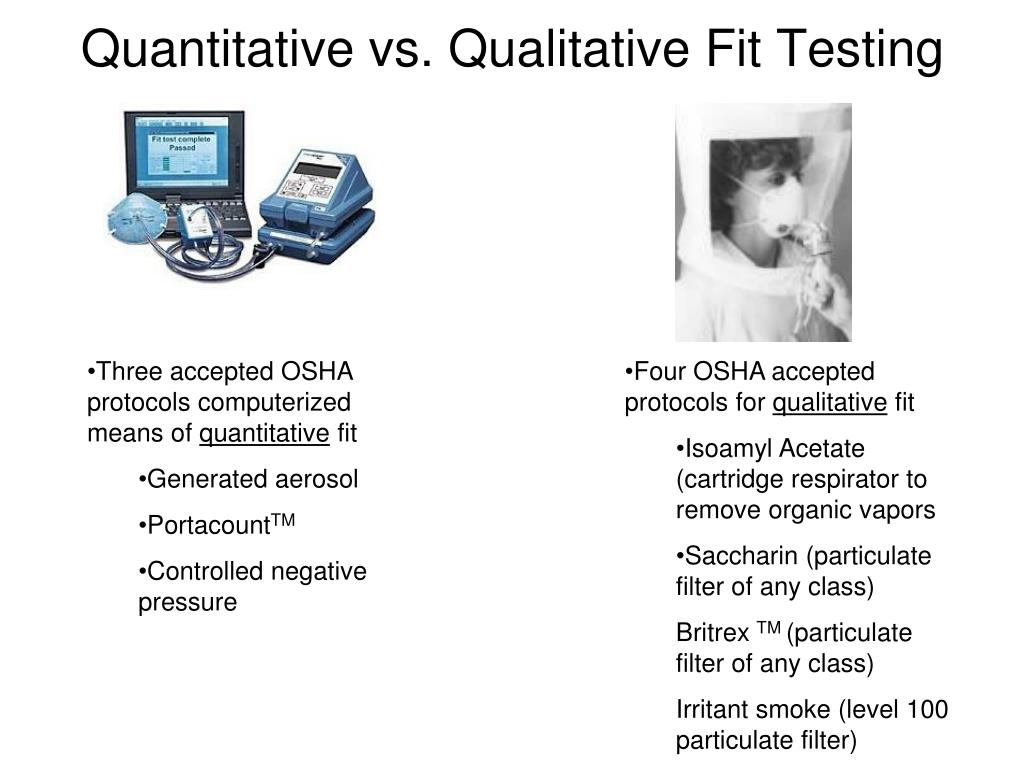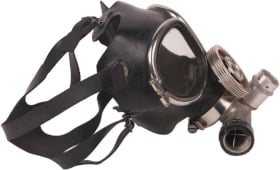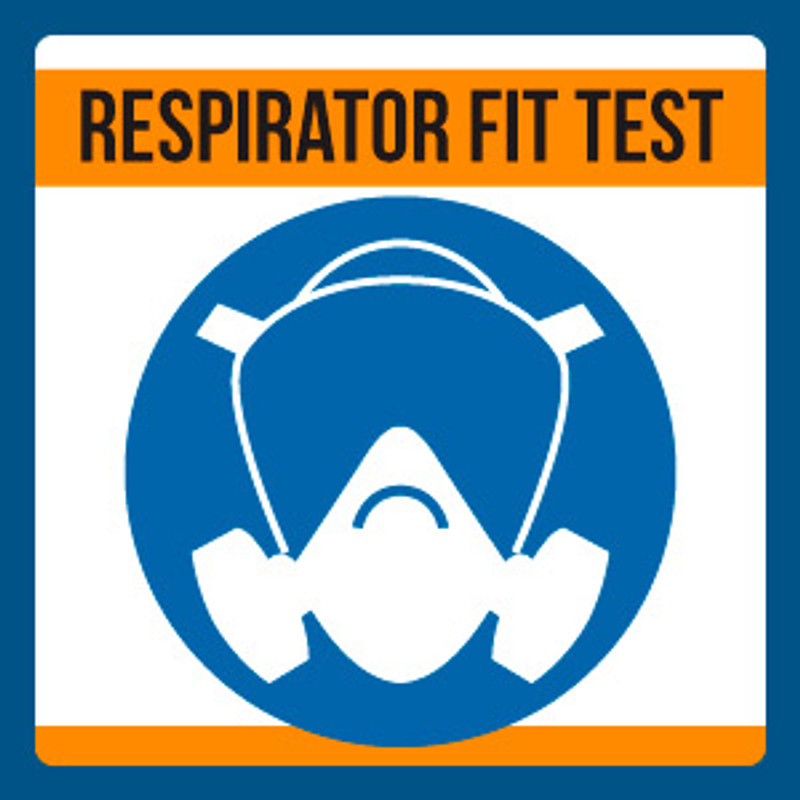Quantitative vs qualitative fit test
Home » Free Imaging » Quantitative vs qualitative fit testQuantitative vs qualitative fit test
Quantitative Vs Qualitative Fit Test. It doesnt measure the amount of leakage into your respirator it will just let you know there is a leak present. A base fit factor of 100 is required for the half. Fit Testing Quantitative Tests. RPA can provide both Qualitative and Quantitative PortaCount tests on-site throughout the UK.
 Figure 1 From Don T Forget About Fit What You Need To Know About Respirator Fit Testing Semantic Scholar From semanticscholar.org
Figure 1 From Don T Forget About Fit What You Need To Know About Respirator Fit Testing Semantic Scholar From semanticscholar.org
Sometimes adapters or other equipment requires a specific model to operate. A quantitative fit test assesses respirator fit by numerically measuring leakage into the respirator. There are two types of fit tests that can be performed as part of the respiratory protection program. Qualitative relies on a fit test administrators ability to perform the steps of a fit test and perform them correctly and consistently across all employees in their programs. 7121 The facepiece seal capability of each member qualified to use RPE shall be verified by quantitative fit test-ing on an annual basis and whenever new types of RPE or facepieces are is-sued. Qualitative fit-test QLFT or quantitative fit-test QNFT.
An unsuccessful qualitative fit test QLFT or quantitative fit test QNFT would indicate that the respirator has not achieved a good facepiece-to-face seal for the worker being tested and the respirator would therefore be expected to deliver less protection than the APF it was assigned in Table 1.
Qualitative fit testing is a passfail test to assess respirator fit based on the individuals response to a test agent. A method of testing that utilizes the wearers reactions to substances. Sometimes adapters or other equipment requires a specific model to operate. For greater concentrations quantitative fit-testing QNFT must be used. The Quantitative PortaCount method can be used to fit test all types of tight-fitting masks including disposable half and full face masks. The process of quantitative face fit testing is quite different.
 Source: safetysolutions.net.au
Source: safetysolutions.net.au
We choose to use the TSI Portacount Pro when performing this method of. The qualitative fit test is normally used for half-mask respirators. Therefore a Quantitative fit test utilizes fit testing hardware to quantify the leakage around the face seal of the respirator veil to give a fit factor. We choose to use the TSI Portacount Pro when performing this method of. Qualitative fit-test QLFT or quantitative fit-test QNFT.

7121 The facepiece seal capability of each member qualified to use RPE shall be verified by quantitative fit test-ing on an annual basis and whenever new types of RPE or facepieces are is-sued. Quantitative and Qualitative tests. Fit test administrators may. A method of testing that utilizes the wearers reactions to substances. Quantitative Fit Testing QNTF Unlike the qualitative test the quantitative test relies on a machine that attaches to the respirator via a tube to measure any leakage.
 Source: link2life.ca
Source: link2life.ca
Qualitative Fit Testing is simply a pass or fail test that uses your sense of smell or taste or your reaction to a known irritant. Qualitative fit-test QLFT or quantitative fit-test QNFT. Respiratory protection standards deem both fit-tests to be acceptable. Arena Convention Centre ACC Liverpool United Kingdom November 26-28 2018 Maxine Dolloway1 Nicolas Kirch2 Josh Schulze3. It doesnt measure the amount of leakage into your respirator it will just let you know there is a leak present.
 Source: blog.prochoice.com.au
Source: blog.prochoice.com.au
There are advantages and disadvantages to qualitative and quantitative fit testing. For all positive pressure atmosphere-supplying respirators either qualitative or quantitative fit testing may be used. Respiratory protection standards deem both fit-tests to be acceptable. It is costlier compared to qualitative fit testing. Its usually used when testing half-mask respirators that cover your nose and mouth such as filtering facepiece respirators N95.
 Source: slidetodoc.com
Source: slidetodoc.com
Therefore a Quantitative fit test utilizes fit testing hardware to quantify the leakage around the face seal of the respirator veil to give a fit factor. Below is a summary of the two types of fit tests as described by OSHA. Qualitative Fit Testing is simply a pass or fail test that uses your sense of smell or taste or your reaction to a known irritant. A quantitative fit test assesses respirator fit by numerically measuring leakage into the respirator. There are two Fit Test methods these are known as.
 Source: semanticscholar.org
Source: semanticscholar.org
A method of testing that utilizes the wearers reactions to substances. This test checks the seal between the respirators face piece and the employees face and usually takes about 15-20 minutes to complete. When quantitative fit-testing is used all full-facepiece respirators must meet or exceed a fit factor of 500 while quarter- and half-mask respirators must meet or exceed 100. We choose to use the TSI Portacount Pro when performing this method of. Qualitative fit testing is a passfail method used on half-masks that relies on senses - such as taste and smell - to detect air leakage from your respirator.
 Source: slideplayer.com
Source: slideplayer.com
Arena Convention Centre ACC Liverpool United Kingdom November 26-28 2018 Maxine Dolloway1 Nicolas Kirch2 Josh Schulze3. Qualitative fit-test QLFT or quantitative fit-test QNFT. 7122 The fit of the RPE of each new member shall be tested before the members are permitted to use RPE in a hazardous atmosphere. Two common fit-test methods can be employed. The quality of the test relies on the competency of each fit test administrator.
 Source: slideserve.com
Source: slideserve.com
An unsuccessful qualitative fit test QLFT or quantitative fit test QNFT would indicate that the respirator has not achieved a good facepiece-to-face seal for the worker being tested and the respirator would therefore be expected to deliver less protection than the APF it was assigned in Table 1. Therefore a Quantitative fit test utilizes fit testing hardware to quantify the leakage around the face seal of the respirator veil to give a fit factor. For greater concentrations quantitative fit-testing QNFT must be used. There are advantages and disadvantages to qualitative and quantitative fit testing. Quantitative and Qualitative tests.
 Source: youtube.com
Source: youtube.com
The half masks being tested much have an overall fit factor mask particle concentration divided by the ambient particle concentration of. The half masks being tested much have an overall fit factor mask particle concentration divided by the ambient particle concentration of. Unlike qualitative methods this type of testing isnt reliant on the person and uses methods such as particle counting to effectively measure the quality of the seal. When quantitative fit-testing is used all full-facepiece respirators must meet or exceed a fit factor of 500 while quarter- and half-mask respirators must meet or exceed 100. Therefore a Quantitative fit test utilizes fit testing hardware to quantify the leakage around the face seal of the respirator veil to give a fit factor.
 Source: xosafety.com
Source: xosafety.com
It is costlier compared to qualitative fit testing. Qualitative Fit Testing is simply a pass or fail test that uses your sense of smell or taste or your reaction to a known irritant. An unsuccessful qualitative fit test QLFT or quantitative fit test QNFT would indicate that the respirator has not achieved a good facepiece-to-face seal for the worker being tested and the respirator would therefore be expected to deliver less protection than the APF it was assigned in Table 1. Qualitative fit testing is a passfail method used on half-masks that relies on senses - such as taste and smell - to detect air leakage from your respirator. A quantitative fit test assesses respirator fit by numerically measuring leakage into the respirator.

QUALITATIVE FIT TESTING Why quantitative testing is the most secure and efficient method for fit testing tight-fitting respirators 11th HIS International Conference HIS 2018. Qualitative fit-test QLFT or quantitative fit-test QNFT. When quantitative fit-testing is used all full-facepiece respirators must meet or exceed a fit factor of 500 while quarter- and half-mask respirators must meet or exceed 100. It doesnt measure the amount of leakage into your respirator it will just let you know there is a leak present. OSHA allows for the use of both qualitative and quantitative tests to evaluate a respirators fit on an individual.
 Source: triumvirate.com
Source: triumvirate.com
Qualitative relies on a fit test administrators ability to perform the steps of a fit test and perform them correctly and consistently across all employees in their programs. When quantitative fit-testing is used all full-facepiece respirators must meet or exceed a fit factor of 500 while quarter- and half-mask respirators must meet or exceed 100. Unlike qualitative methods this type of testing isnt reliant on the person and uses methods such as particle counting to effectively measure the quality of the seal. Therefore a Quantitative fit test utilizes fit testing hardware to quantify the leakage around the face seal of the respirator veil to give a fit factor. Just a single representative might be fit tested at once.
 Source: pksafety.com
Source: pksafety.com
The half masks being tested much have an overall fit factor mask particle concentration divided by the ambient particle concentration of. A base fit factor of 100 is required for the half. The process of quantitative face fit testing is quite different. Below is a summary of the two types of fit tests as described by OSHA. Respiratory protection standards deem both fit-tests to be acceptable.
 Source: vpppa.org
Source: vpppa.org
For greater concentrations quantitative fit-testing QNFT must be used. Fit test administrators may. Sometimes adapters or other equipment requires a specific model to operate. 7121 The facepiece seal capability of each member qualified to use RPE shall be verified by quantitative fit test-ing on an annual basis and whenever new types of RPE or facepieces are is-sued. A base fit factor of 100 is required for the half.
 Source: mit-tec.com
Source: mit-tec.com
There are two types of fit tests that can be performed as part of the respiratory protection program. If youre testing a full-face respirator the quantitative fit test is recommended instead. OSHA allows for the use of both qualitative and quantitative tests to evaluate a respirators fit on an individual. The Quantitative PortaCount method can be used to fit test all types of tight-fitting masks including disposable half and full face masks. We choose to use the TSI Portacount Pro when performing this method of.
If you find this site adventageous, please support us by sharing this posts to your own social media accounts like Facebook, Instagram and so on or you can also save this blog page with the title quantitative vs qualitative fit test by using Ctrl + D for devices a laptop with a Windows operating system or Command + D for laptops with an Apple operating system. If you use a smartphone, you can also use the drawer menu of the browser you are using. Whether it’s a Windows, Mac, iOS or Android operating system, you will still be able to bookmark this website.